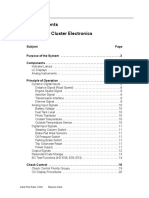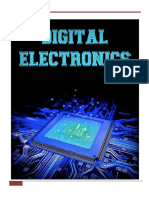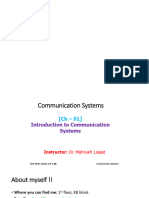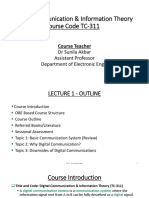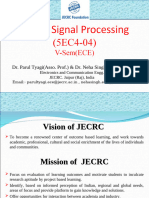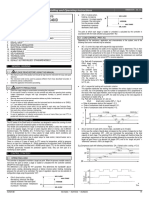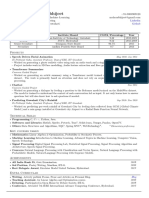Module 1.1
Uploaded by
swaraj.patel2021Module 1.1
Uploaded by
swaraj.patel2021BECE306L - Digital Communication Systems
Fall Intra (2023-24)
Course Instructor
D r. T. I l a v a r a s a n
⦁ School of Electronics Engineering
⦁ Mail:ilavarasan.t@vit.ac.in
⦁ Contact:+91-9790040384
⦁ Cabin :SigmaBlock –L4
2 Dr. T.Ilavarasan, Associate Professor,SENSE, VIT
Guidelines to be followed:
⦁ Be on time for the class as per the schedule.
⦁ Always have a dedicated notebook and your own calculator to solve the numerical
problems during the class hours.
⦁ Stick to the deadlines for theAssignments,Quizzes and other assessment activities.
⦁ Be attentive and ask your doubts then and there during the class hours.
⦁ Feel free to share your views towards the course/topic and the instructor regarding the
content delivery.
⦁ Let it be more of a discussion and Happy learning for all..!!
3 Dr. T.Ilavarasan, Associate Professor,SENSE, VIT
General course information:
⦁ Prerequisite – BECE206L/Analog Communication System
⦁ Important concepts will be explained qualitatively using real-life examples
⦁ However, as an engineering student, extensive use of mathematics is necessary for
accurate system modelling and analysis
⦁ Theory – 3 credits - 3 hrs per week – Totally 45 hrs
⦁ Lab – 1 credit – 2 hrs per week
4 Dr. T.Ilavarasan, Associate Professor,SENSE, VIT
Course objectives:
⦁ To understand the transmitter and receiver blocks of various waveform coding
techniques.
⦁ To analyze various line coding techniques in time and frequency domains.
⦁ To identify the role of baseband, bandpass formats and information theory for effective
transmission of signals, combat ISI and to increase the reliability of transmission.
⦁ To understand the principles and importance of spread spectrum and multiple access in
the context of communication.
5 Dr. T.Ilavarasan, Associate Professor,SENSE, VIT
Course outcomes:
⦁ Comprehend the sampling and quantization process to recover the original signal.
⦁ Analyse the performance of various waveform and Line coding techniques.
⦁ Design the various baseband pulses for ISI free transmission over finite bandwidth
channels.
⦁ Examine the BER and bandwidth efficiency of the Bandpass modulation techniques.
⦁ Analyse the digital communication system with spread spectrum modulation.
⦁ Infer the elements of information theory.
6 Dr. T.Ilavarasan, Associate Professor,SENSE, VIT
Syllabus
⦁ Module:1 Sampling Process
⦁ Module:2 Waveform Coding Techniques
⦁ Module:3 Line Codes
⦁ Module:4 Baseband System
⦁ Module:5 Bandpass System
⦁ Module:6 Spread SpectrumTechniques and Multiple AccessTechniques
⦁ Module:7 Introduction to Information Theory
7 Dr. T.Ilavarasan, Associate Professor,SENSE, VIT
Text/Reference Books
⦁ Simon Haykin, Digital Communications, 2017, 1st Edition, John Wiley, India.
⦁ John G. Proakis, Masoud Salehi, Digital Communication, 2018, 5th Edition (Indian edition),
Mc Graw Hill Education, India.
⦁ Bernard Sklar and Fredric J. Harris, Digital Communications: Fundamentals and
Applications, 2020, 3rd Edition, Pearson , UK.
⦁ B P Lathi, Zhi Ding, Modern Digital And Analog Communication Systems, 2017, 4th Edition,
Oxford university Press, India
8 Dr. T.Ilavarasan, Associate Professor,SENSE, VIT
Evaluation Metrics
⦁ DA – 1 – 10 marks
⦁ Quiz – 1 - 10 marks (After CAT-1)
⦁ Quiz – 2 - 10 marks (After CAT-2)
⦁ CAT – 1 – 15 marks
⦁ CAT – 2 – 15 marks
⦁ FAT – 40 marks
9 Dr. T.Ilavarasan, Associate Professor,SENSE, VIT
Introduction
⦁ Communication has been one of the deepest needs of the human race throughout
recorded history.
⦁ It is essential to forming social unions, to educating the young, and to expressing a myriad
of emotions and needs.
⦁ Good communication is central to a civilized society.
⦁ The communication that occurs in our day-to-day life is in the form of signals.
⦁ These signals,such as sound signals,generally,are analog in nature.
⦁ When the communication needs to be established over a distance, then the analog signals
are sent using different techniques for effective transmission.
10 Dr. T.Ilavarasan, Associate Professor,SENSE, VIT
Introduction
⦁ Main purpose of communication is to transfer information from a source to a recipient
via a channel or medium.
⦁ Basic block diagram of a communication system:
11 Dr. T.Ilavarasan, Associate Professor,SENSE, VIT
Introduction
Basic Description
⦁ Source:analog or digital
⦁ Transmitter: transducer, amplifier,modulator, oscillator, power amp., antenna
⦁ Channel: e.g.cable,optical fibre,free space
⦁ Receiver: antenna,amplifier,demodulator, oscillator, power amplifier,transducer
⦁ Recipient:e.g.person,(loud) speaker,computer
12 Dr. T.Ilavarasan, Associate Professor,SENSE, VIT
Introduction
⦁ Types of information
Voice,data,video,music,email etc.
⦁ Types of communication systems
Public SwitchedTelephone Network
(voice,fax,modem) Satellite systems
Radio,TV
broadcasting Cellular
phones
Computer networks (LANs,WANs,WLANs)
13 Dr. T.Ilavarasan, Associate Professor,SENSE, VIT
Introduction
⦁ Communication system converts information into electrical electromagnetic/optical
signals appropriate for the transmission medium.
⦁ Analog systems convert analog message into signals that can propagate through the
channel.
⦁ Digital systems convert bits(digits,symbols) into signals
⦁ Computers naturally generate information as characters/bits
⦁ Most information can be converted into bits
⦁ Analog signals converted to bits by sampling and quantizing (A/D conversion)
14 Dr. T.Ilavarasan, Associate Professor,SENSE, VIT
History of communication system
15 Dr. T.Ilavarasan, Associate Professor,SENSE, VIT
The Necessity of Digitization
⦁ Why are communication systems, military and commercial alike, “going digital”? There
are many reasons,
⦁ Analog signals suffer from many losses such as distortion, interference, and other losses
including security breach.
⦁ In order to overcome these problems,the signals are digitized using different techniques.
16 Dr. T.Ilavarasan, Associate Professor,SENSE, VIT
The Necessity of Digitization
⦁ The primary advantage is the ease with which digital signals, compared with analog
signals, are regenerated.
Original Regenerated
pulse pulse
17 Dr. T.Ilavarasan, Associate Professor,SENSE, VIT
Analog versus Digital
•Harder to separate noise from an analog
signal than from a digital signal
•If there is too much noise cannot
discern a high voltage from a low voltage
18 Dr. T.Ilavarasan, Associate Professor,SENSE, VIT
Digital Communication System
⦁ By definition, are communication systems that uses digital sequence as an interface between
the source and the channel input and similarly between the channel output and final
destination.
19 Dr. T.Ilavarasan, Associate Professor,SENSE, VIT
Digital Communication System
⦁ There are a number of reasons why digital communication systems are now standard,
briefly they are as follows:
1. Digital hardware has become so cheap, reliable, and miniaturized, that digital interfaces
are eminently practical.
2. A standardized binary interface between source and channel simplifies implementation
and understanding.
⦁ Since source coding/decoding can be done independently of the channel.
⦁ Similarly,channel coding/decoding can be done independently of the source.
3. A standardized binary interface between source and channel simplifies networking.
20 Dr. T.Ilavarasan, Associate Professor,SENSE, VIT
Digital Communication
Systems:
Block Diagram
21 Dr. T.Ilavarasan, Associate Professor,SENSE, VIT
Digital Communication System
⦁ The basic signal processing functions,which may be viewed as transformations,classified into
the following nine groups:
1. Formatting and source coding
2. Baseband signalling
3. Bandpass signalling
4. Equalization
5. C hannel coding
6. Multiplexing and multiple access
7. Spreading
8. Encryption
9. Synchronization
22 Dr. T.Ilavarasan, Associate Professor,SENSE, VIT
23 Dr. T.Ilavarasan, Associate Professor,SENSE, VIT
Advantages of Digital Communication
⦁ The effect of distortion, noise, and interference is much less in digital signals as they are
less affected.
⦁ Digital circuits are more reliable.
⦁ Digital circuits are easy to design and cheaper than analog circuits.
⦁ The hardware implementation in digital circuits,is more flexible than analog.
⦁ The occurrence of cross-talk is very rare in digital communication.
⦁ The signal is un-altered as the pulse needs a high disturbance to alter its properties, which
is very difficult.
⦁ Signal processing functions such as encryption and compressionare employed in digital
circuits to maintain the secrecy of the information.
24 Dr. T.Ilavarasan, Associate Professor,SENSE, VIT
Advantages of Digital Communication
⦁ The probability of error occurrence is reduced by employing error detecting and error
correcting codes.
⦁ Spread spectrum technique is used to avoid signal jamming.
⦁ Combiningdigital signals using Time DivisionMultiplexingTDM is easier than
combining analog signals using Frequency Division Multiplexing FDM.
⦁ The configuring process of digital signals is easier than analog signals.
⦁ Digital signals can be saved and retrieved more conveniently than analog signals.
⦁ Many of the digital circuits have almost common encoding techniques and hence
similar devices can be used for a number of purposes.
⦁ The capacity of the channel is effectively utilized by digital signals.
25 Dr. T.Ilavarasan, Associate Professor,SENSE, VIT
You might also like
- BMW IKE E38 E39 E53 Instrument Cluster Electronics100% (2)BMW IKE E38 E39 E53 Instrument Cluster Electronics23 pages
- Physics Project: Topic - Communication System75% (4)Physics Project: Topic - Communication System13 pages
- Canon IR3245 - Ir3225 - Ir3230 - Ir3235 Series Service Manual86% (7)Canon IR3245 - Ir3225 - Ir3230 - Ir3235 Series Service Manual746 pages
- Investigatory Project: Exploring The Principles of Analog and Digital Communication'No ratings yetInvestigatory Project: Exploring The Principles of Analog and Digital Communication'16 pages
- Download Full Image Processing Technologies Algorithms Sensors and Applications Signal Processing and Communications 1st Edition Kiyoharu Aizawa PDF All Chapters100% (4)Download Full Image Processing Technologies Algorithms Sensors and Applications Signal Processing and Communications 1st Edition Kiyoharu Aizawa PDF All Chapters51 pages
- [FREE PDF sample] Image Processing Technologies Algorithms Sensors and Applications Signal Processing and Communications 1st Edition Kiyoharu Aizawa ebooks100% (12)[FREE PDF sample] Image Processing Technologies Algorithms Sensors and Applications Signal Processing and Communications 1st Edition Kiyoharu Aizawa ebooks37 pages
- [Ebooks PDF] download High Resolution and Robust Signal Processing 1st Edition Yingbo Hua (Editor) full chapters100% (6)[Ebooks PDF] download High Resolution and Robust Signal Processing 1st Edition Yingbo Hua (Editor) full chapters50 pages
- Get High Resolution and Robust Signal Processing 1st Edition Yingbo Hua (Editor) free all chaptersNo ratings yetGet High Resolution and Robust Signal Processing 1st Edition Yingbo Hua (Editor) free all chapters41 pages
- (Ebook) Modulated Coding for Intersymbol Interference Channels by Xiang-Gen Xia ISBN 9780824704599, 0824704592 instant download100% (2)(Ebook) Modulated Coding for Intersymbol Interference Channels by Xiang-Gen Xia ISBN 9780824704599, 0824704592 instant download42 pages
- Light Weight Security and Authentication in Wireless Body Area NetworkNo ratings yetLight Weight Security and Authentication in Wireless Body Area Network9 pages
- Silent-Sound-Technology-The-Future-of-Communication.pptxNo ratings yetSilent-Sound-Technology-The-Future-of-Communication.pptx16 pages
- 3-Module - 1 Overview of Computer and Communication Networks-03-01-2024No ratings yet3-Module - 1 Overview of Computer and Communication Networks-03-01-202419 pages
- Pub Digital Signal Processing For Multimedia Systems S100% (1)Pub Digital Signal Processing For Multimedia Systems S880 pages
- Instant download Modulated Coding for Intersymbol Interference Channels 1st Edition Xiang-Gen Xia pdf all chapterNo ratings yetInstant download Modulated Coding for Intersymbol Interference Channels 1st Edition Xiang-Gen Xia pdf all chapter85 pages
- Digital Communication & Information Theory Course Code TC-311No ratings yetDigital Communication & Information Theory Course Code TC-31118 pages
- Data Transmission Enhancement Using Optimal Coding Technique Over In-Vivo Channel For Inter Body CommunicationNo ratings yetData Transmission Enhancement Using Optimal Coding Technique Over In-Vivo Channel For Inter Body Communication33 pages
- Dissertation Topics in Electronics and Communication100% (1)Dissertation Topics in Electronics and Communication4 pages
- Modulated Coding for Intersymbol Interference Channels 1st Edition Xiang-Gen Xia - Download the ebook now to start reading without waitingNo ratings yetModulated Coding for Intersymbol Interference Channels 1st Edition Xiang-Gen Xia - Download the ebook now to start reading without waiting74 pages
- Watermarking Systems Engineering Enabling Digital Assets Security and Other Applications 1st Edition Mauro Barni - Download the ebook now for full and detailed access100% (1)Watermarking Systems Engineering Enabling Digital Assets Security and Other Applications 1st Edition Mauro Barni - Download the ebook now for full and detailed access41 pages
- Watermarking Systems Engineering Enabling Digital Assets Security and Other Applications 1st Edition Mauro Barni instant downloadNo ratings yetWatermarking Systems Engineering Enabling Digital Assets Security and Other Applications 1st Edition Mauro Barni instant download55 pages
- Get Watermarking Systems Engineering Enabling Digital Assets Security and Other Applications 1st Edition Mauro Barni PDF ebook with Full Chapters Now100% (19)Get Watermarking Systems Engineering Enabling Digital Assets Security and Other Applications 1st Edition Mauro Barni PDF ebook with Full Chapters Now60 pages
- Speech Processing A Dynamic and Optimization Oriented Approach 1st Edition Li Deng (Author) downloadNo ratings yetSpeech Processing A Dynamic and Optimization Oriented Approach 1st Edition Li Deng (Author) download55 pages
- We Are Intechopen, The World'S Leading Publisher of Open Access Books Built by Scientists, For ScientistsNo ratings yetWe Are Intechopen, The World'S Leading Publisher of Open Access Books Built by Scientists, For Scientists23 pages
- Watermarking Systems Engineering Enabling Digital Assets Security and Other Applications 1st Edition Mauro Barni 2024 Scribd Download100% (4)Watermarking Systems Engineering Enabling Digital Assets Security and Other Applications 1st Edition Mauro Barni 2024 Scribd Download51 pages
- UT Dallas Syllabus For Ee6352.501.07s Taught by Hlaing Minn (hxm025000)No ratings yetUT Dallas Syllabus For Ee6352.501.07s Taught by Hlaing Minn (hxm025000)5 pages
- (4) Design of Translator Glove for Deaf-Mute AlphabetNo ratings yet(4) Design of Translator Glove for Deaf-Mute Alphabet4 pages
- Ngo Quoc Hien Massive Mimo Fundamentals and System Designs100% (1)Ngo Quoc Hien Massive Mimo Fundamentals and System Designs301 pages
- Secured Data Transmission Using Ellipticcurve CryptographyNo ratings yetSecured Data Transmission Using Ellipticcurve Cryptography7 pages
- Wireless Interfaces For IEEE 1451 Sensor NetworksNo ratings yetWireless Interfaces For IEEE 1451 Sensor Networks6 pages
- Using Digital Stethoscopes in Remote Patient Assessment Via Wireless Networks: The User's PerspectiveNo ratings yetUsing Digital Stethoscopes in Remote Patient Assessment Via Wireless Networks: The User's Perspective7 pages
- Best Books For GATE Electronics and Communication (ECE) 2024No ratings yetBest Books For GATE Electronics and Communication (ECE) 20245 pages
- Lab Manual: Digital Electronics Lab (EC 214 B) : Experiment No: 01No ratings yetLab Manual: Digital Electronics Lab (EC 214 B) : Experiment No: 0124 pages
- Certificates and Test Reports DPV Pumps and Booster SystemsNo ratings yetCertificates and Test Reports DPV Pumps and Booster Systems48 pages
- 3500/25 Enhanced Keyphasor Module: Bently Nevada Asset Condition MonitoringNo ratings yet3500/25 Enhanced Keyphasor Module: Bently Nevada Asset Condition Monitoring7 pages
- Automatic Simulation Measurement and Verification of Inputs and Outputs of Body Control ModuleNo ratings yetAutomatic Simulation Measurement and Verification of Inputs and Outputs of Body Control Module4 pages
- Download Medical Imaging Systems Andreas Maier ebook All Chapters PDF100% (2)Download Medical Imaging Systems Andreas Maier ebook All Chapters PDF62 pages
- Expt - 2 - Frequency Analysis of Signals Using DFTNo ratings yetExpt - 2 - Frequency Analysis of Signals Using DFT6 pages
- Chapter 2 Signal Analysis and Mixing Tomasi ReviewNo ratings yetChapter 2 Signal Analysis and Mixing Tomasi Review5 pages
- Performance Analysis of Digital Communication Systems: Unit: 3No ratings yetPerformance Analysis of Digital Communication Systems: Unit: 349 pages
- An Internet-Of-Things IoT System Development and INo ratings yetAn Internet-Of-Things IoT System Development and I8 pages
- Electronics and Computer Science EngineeringNo ratings yetElectronics and Computer Science Engineering147 pages
- Vibrocontrol 1500: Operating InstructionsNo ratings yetVibrocontrol 1500: Operating Instructions12 pages
- BMW IKE E38 E39 E53 Instrument Cluster ElectronicsBMW IKE E38 E39 E53 Instrument Cluster Electronics
- Canon IR3245 - Ir3225 - Ir3230 - Ir3235 Series Service ManualCanon IR3245 - Ir3225 - Ir3230 - Ir3235 Series Service Manual
- Investigatory Project: Exploring The Principles of Analog and Digital Communication'Investigatory Project: Exploring The Principles of Analog and Digital Communication'
- Download Full Image Processing Technologies Algorithms Sensors and Applications Signal Processing and Communications 1st Edition Kiyoharu Aizawa PDF All ChaptersDownload Full Image Processing Technologies Algorithms Sensors and Applications Signal Processing and Communications 1st Edition Kiyoharu Aizawa PDF All Chapters
- [FREE PDF sample] Image Processing Technologies Algorithms Sensors and Applications Signal Processing and Communications 1st Edition Kiyoharu Aizawa ebooks[FREE PDF sample] Image Processing Technologies Algorithms Sensors and Applications Signal Processing and Communications 1st Edition Kiyoharu Aizawa ebooks
- [Ebooks PDF] download High Resolution and Robust Signal Processing 1st Edition Yingbo Hua (Editor) full chapters[Ebooks PDF] download High Resolution and Robust Signal Processing 1st Edition Yingbo Hua (Editor) full chapters
- Get High Resolution and Robust Signal Processing 1st Edition Yingbo Hua (Editor) free all chaptersGet High Resolution and Robust Signal Processing 1st Edition Yingbo Hua (Editor) free all chapters
- (Ebook) Modulated Coding for Intersymbol Interference Channels by Xiang-Gen Xia ISBN 9780824704599, 0824704592 instant download(Ebook) Modulated Coding for Intersymbol Interference Channels by Xiang-Gen Xia ISBN 9780824704599, 0824704592 instant download
- Light Weight Security and Authentication in Wireless Body Area NetworkLight Weight Security and Authentication in Wireless Body Area Network
- Silent-Sound-Technology-The-Future-of-Communication.pptxSilent-Sound-Technology-The-Future-of-Communication.pptx
- 3-Module - 1 Overview of Computer and Communication Networks-03-01-20243-Module - 1 Overview of Computer and Communication Networks-03-01-2024
- Pub Digital Signal Processing For Multimedia Systems SPub Digital Signal Processing For Multimedia Systems S
- Instant download Modulated Coding for Intersymbol Interference Channels 1st Edition Xiang-Gen Xia pdf all chapterInstant download Modulated Coding for Intersymbol Interference Channels 1st Edition Xiang-Gen Xia pdf all chapter
- Digital Communication & Information Theory Course Code TC-311Digital Communication & Information Theory Course Code TC-311
- Data Transmission Enhancement Using Optimal Coding Technique Over In-Vivo Channel For Inter Body CommunicationData Transmission Enhancement Using Optimal Coding Technique Over In-Vivo Channel For Inter Body Communication
- Dissertation Topics in Electronics and CommunicationDissertation Topics in Electronics and Communication
- Modulated Coding for Intersymbol Interference Channels 1st Edition Xiang-Gen Xia - Download the ebook now to start reading without waitingModulated Coding for Intersymbol Interference Channels 1st Edition Xiang-Gen Xia - Download the ebook now to start reading without waiting
- Watermarking Systems Engineering Enabling Digital Assets Security and Other Applications 1st Edition Mauro Barni - Download the ebook now for full and detailed accessWatermarking Systems Engineering Enabling Digital Assets Security and Other Applications 1st Edition Mauro Barni - Download the ebook now for full and detailed access
- Watermarking Systems Engineering Enabling Digital Assets Security and Other Applications 1st Edition Mauro Barni instant downloadWatermarking Systems Engineering Enabling Digital Assets Security and Other Applications 1st Edition Mauro Barni instant download
- Get Watermarking Systems Engineering Enabling Digital Assets Security and Other Applications 1st Edition Mauro Barni PDF ebook with Full Chapters NowGet Watermarking Systems Engineering Enabling Digital Assets Security and Other Applications 1st Edition Mauro Barni PDF ebook with Full Chapters Now
- Speech Processing A Dynamic and Optimization Oriented Approach 1st Edition Li Deng (Author) downloadSpeech Processing A Dynamic and Optimization Oriented Approach 1st Edition Li Deng (Author) download
- We Are Intechopen, The World'S Leading Publisher of Open Access Books Built by Scientists, For ScientistsWe Are Intechopen, The World'S Leading Publisher of Open Access Books Built by Scientists, For Scientists
- Watermarking Systems Engineering Enabling Digital Assets Security and Other Applications 1st Edition Mauro Barni 2024 Scribd DownloadWatermarking Systems Engineering Enabling Digital Assets Security and Other Applications 1st Edition Mauro Barni 2024 Scribd Download
- UT Dallas Syllabus For Ee6352.501.07s Taught by Hlaing Minn (hxm025000)UT Dallas Syllabus For Ee6352.501.07s Taught by Hlaing Minn (hxm025000)
- (4) Design of Translator Glove for Deaf-Mute Alphabet(4) Design of Translator Glove for Deaf-Mute Alphabet
- Ngo Quoc Hien Massive Mimo Fundamentals and System DesignsNgo Quoc Hien Massive Mimo Fundamentals and System Designs
- Secured Data Transmission Using Ellipticcurve CryptographySecured Data Transmission Using Ellipticcurve Cryptography
- Using Digital Stethoscopes in Remote Patient Assessment Via Wireless Networks: The User's PerspectiveUsing Digital Stethoscopes in Remote Patient Assessment Via Wireless Networks: The User's Perspective
- Best Books For GATE Electronics and Communication (ECE) 2024Best Books For GATE Electronics and Communication (ECE) 2024
- Lab Manual: Digital Electronics Lab (EC 214 B) : Experiment No: 01Lab Manual: Digital Electronics Lab (EC 214 B) : Experiment No: 01
- Certificates and Test Reports DPV Pumps and Booster SystemsCertificates and Test Reports DPV Pumps and Booster Systems
- 3500/25 Enhanced Keyphasor Module: Bently Nevada Asset Condition Monitoring3500/25 Enhanced Keyphasor Module: Bently Nevada Asset Condition Monitoring
- Automatic Simulation Measurement and Verification of Inputs and Outputs of Body Control ModuleAutomatic Simulation Measurement and Verification of Inputs and Outputs of Body Control Module
- Download Medical Imaging Systems Andreas Maier ebook All Chapters PDFDownload Medical Imaging Systems Andreas Maier ebook All Chapters PDF
- Expt - 2 - Frequency Analysis of Signals Using DFTExpt - 2 - Frequency Analysis of Signals Using DFT
- Chapter 2 Signal Analysis and Mixing Tomasi ReviewChapter 2 Signal Analysis and Mixing Tomasi Review
- Performance Analysis of Digital Communication Systems: Unit: 3Performance Analysis of Digital Communication Systems: Unit: 3
- An Internet-Of-Things IoT System Development and IAn Internet-Of-Things IoT System Development and I
